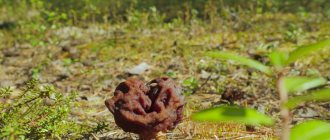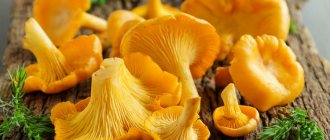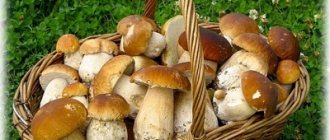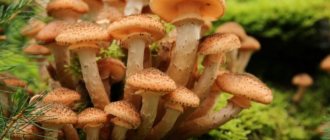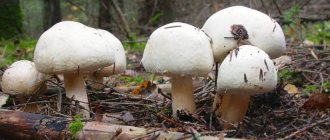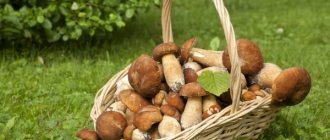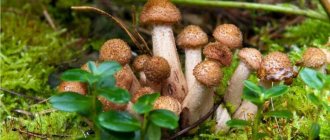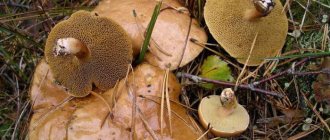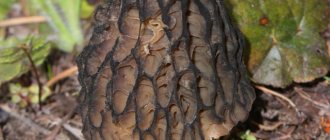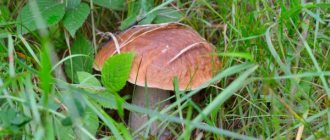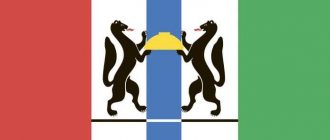Saffron milk caps
Rizhik, thanks to its taste and appetizing appearance, is deservedly considered one of the best mushrooms of the Russula family. You can find several species in the forests and, having spotted any of them, you need to hurry up and collect delicious orange mushrooms, since they quickly become worm-like and age, crumbling into dust.
These mushrooms got their sonorous name not only for the bright color of their skin, but also for their inherent carrot-orange color of milky juice.
Camelina mushrooms: common features and unique properties
In total, about a dozen saffron milk caps are known. They belong to the Russula family and belong to the Milky Way genus - which, by the way, also includes the noble milk mushrooms [1] In general, one can say that the saffron milk cap is also a milk mushroom, albeit somewhat unique.. The saffron milk caps are united by one common feature - all they are orange in color with some variations in one shade or another, and their milky juice is usually also orange or reddish.
Almost all saffron milk caps form mycorrhiza [2]. Mycorrhiza is the scientific name for the union of a fungus and some higher plant, for example, a tree. The essence of this symbiotic union is that the mycelium entangles the root of the plant and penetrates it. Next, a mutually beneficial exchange takes place between the fungus and the plant: the former provides water and minerals in abundance - much more than the plant could extract from the soil. It does not remain in debt and supplies the fungus with valuable organic substances - carbohydrates, amino acids, etc. with various conifers.
Photo 2. Coniferous forest is a typical biotope where saffron milk caps grow.
An old Russian proverb says: “Ryzhiki grow generously there, where there are spruces, pines, fir, and cedars.”
Only one mushroom prefers to enter into symbiosis with broad-leaved tree species. True, he is somewhat far-fetched for saffron milk caps.
Photo 3. Mixed birch-spruce-fir forest is another place where saffron milk caps grow.
As for the taste, saffron milk caps have excellent taste; moreover, in many countries these mushrooms are considered a true delicacy. I cannot disagree with this, because I myself adore saffron milk caps - especially when salted. By the way, pickling is the best way to cook them. You can, of course, marinate, fry, stew, cook soup, but it is in the salted form that their unique taste is fully revealed. Yes, almost all saffron milk caps do not require pre-soaking or boiling - unlike most other milk mushrooms, whose juice is very caustic, if not completely poisonous.
Some (including very authoritative) Internet sources claim that saffron milk caps are not suitable for drying. Complete nonsense! Mushrooms dry well and quickly, and are very edible in this form.
Dried saffron milk caps can be finely ground in a meat grinder or coffee grinder to obtain mushroom powder. It is added to soups, purees, salads and other dishes - as a seasoning or as the main ingredient.
In addition to their excellent taste, saffron milk caps are also known for their energy qualities - when processed, they are noticeably superior in calories to beef, chicken, herring and chicken eggs. In addition, saffron milk caps contain a number of valuable proteins and amino acids, which is why they can replace meat and fish for a certain period of time. The content of some vitamins in them is also increased, especially a lot of carotene-A (this vitamin, by the way, provided them with a characteristic color - like the same carrot). Therefore, saffron milk caps are not only very nutritious, but also good for health.
But this, as it turned out, is not all of what these mushrooms are famous for. Some types of saffron milk caps contain lactriovioline, a powerful natural antibiotic that suppresses the development of many bacteria and fungi, including tuberculosis bacillus. Camelinas have long been used in folk medicine; they are also used to make medicines industrially.
It has been scientifically established that the juice from fresh fruiting bodies of camelina has antimicrobial properties (will be described in detail in the next chapter). Half a milligram of this substance is equivalent in its medicinal strength to 0.01 mg of penicillin.
That's how wonderful they are. And now it’s time to consider each of the saffron mushrooms separately.
Benefits and rules of cooking
The benefits and harms of these mushrooms are being actively studied by scientists today. They are not only nutritious and a storehouse of useful microelements, but also have a healing effect.
Medicinal properties
A substance was discovered in their composition that helps fight tuberculosis and oncology. Saffron milk caps are easily absorbed in the human body, saturating it and satisfying the need for vitamins and microelements. They are classified in the first category of edibility.
Good to know! The orange color of the fruit body is associated with the presence of beta-carotene in the pulp and skin - vitamin A, which is a powerful antioxidant. These mushrooms also contain B vitamins and ascorbic acid.
The maximum benefit comes from eating peeled and washed raw fruiting bodies. They are eaten sprinkled with salt. This is exactly how it is recommended to eat these mushrooms as a cure for pulmonary tuberculosis. Saffron milk caps help fight cancer: 100 g of them should be eaten raw daily.
Restrictions on use
They are contraindicated for those who suffer from pancreatitis or cholecystitis.
Restrictions on mushroom consumption
It is not recommended to take them as food for people with intestinal obstructions and people with low stomach acidity.
The saffron milk cap is real
Photo 4. Here it is - a real saffron milk cap, the standard of taste among other saffron milk caps. Photo credit: Electrostatico.
It is also common saffron milk cap , pine saffron milk cap . It also has other names - autumn , pine forest , delicacy , noble . It is clear that the mushroom received some of these epithets for its excellent taste. And indeed, many mushroom pickers are inclined to believe that pine saffron milk cap is the best among its fellows. The author of these lines is of the same opinion. In my opinion, properly washed, salted and aged pine saffron milk caps are just a great snack [3] By the way, in Rus' in the old days people didn’t bother at all and often snacked on vodka with raw saffron milk caps that were only lightly salted on top.. If you chop them with onions and season with vegetable oil or sour cream - you get a wonderful salad that goes very harmoniously with crumbly boiled potatoes.
The common camelina is quite widely distributed, found in both the European and Asian parts of the continent. Very recognizable due to its bright orange cap.
This fungus, of course, forms mycorrhiza with pine. Therefore, you need to look for it where this tree grows. However, the presence of pine trees in the forest is not the main condition. The pine saffron milk cap loves warmth, so it is most often found at the edges of clearings, in clearings, clearings, along the sides of forest roads - where the sun warms the ground well. But it grows especially en masse in young pine forests, where the trees are about 4-5 meters high. Loves mossy or grassy places.
Photo 5. A young pine forest is a place where saffron milk caps grow densely and gather in large quantities.
In such forests, saffron milk caps grow together, and sometimes so densely that you can collect at least a medium-sized bucket of them from one square meter.
I remember once I was collecting saffron milk caps in a similar pine forest that grew up on the site of an abandoned village in the distant Bashkir wilderness. The forest was about 10 years old - the height of the trees did not exceed 4 meters. The pine trees grew quite densely and at their feet there were thick layers of sphagnum moss. And on top there was a real mushroom “Klondike” - a real carpet of saffron milk caps, which here and there stood in dense, numerous herds. I remember how I greedily pounced on mushrooms, how I cut hundreds of them, filling baskets, bags, a jacket, a sweater - everything I could carry. And this despite the fact that I chose only more or less young mushrooms, because there were twice as many old, overgrown burdocks growing there. On top of everything else, a good third of the mushrooms turned out to be wormy - they had to be thrown away. Somehow I overcame my own greed and stopped in time - otherwise I would hardly have been able to steal the collected mushrooms from the forest. But I’m sure - if I had a team and more containers then - I could have taken a hundred buckets from that fishing line. By the way, a river flowed not far from it - I immediately suspected that this could be one of the positive factors that ensured such a breathtaking yield for saffron milk caps in that place. Subsequent observations in other forests only confirmed this.
The period of fruiting of the true saffron milk cap is very extended. Its fruiting bodies are found both at the beginning of June - along with the first boletus, and at the end of October - before the first stable snow cover. However, its most massive “waves” are observed in mid-summer and early autumn .
Places of growth
So where do the different species grow? Spruce forests with dense grass and foliage are loved by representatives of the spruce species. Accordingly, their pine counterparts chose young pine forests and sandstones.
It is important to know what these mushrooms look like. The pine saffron milkweed is very similar to the moth, and it can be extremely difficult to distinguish them. In addition to spruce forests and pine forests, both of these true individuals willingly settle in larch plantings.
Despite its bright coloring, the saffron milk cap shows miracles of secrecy and perfectly camouflages itself in the grass. In order to detect it, you need to thoroughly examine the grass.
If there are no worms in the mushroom stem, then there are none in the entire fruit body
Spruce mushroom
Photo 6. Spruce mushroom. Photo by: Th. Kuhnigk.
He is also a green saffron milk cap . This mushroom is very similar in appearance to the previous one, but seasoned mushroom pickers never confuse them, unlike inexperienced mushroom pickers. Spruce saffron milk cap differs from pine saffron primarily in that it is smaller and more fragile; in addition, its cap is more monochromatic and paler. Also, a bluish-greenish coating is almost always observed on its upper surface, and the older the saffron milk cap is, the more clearly it appears.
It is quite obvious that spruce saffron grows not under pines, but under fir trees. It is very widespread - you can find it wherever these trees are - in real dark urmans and in mixed forests, where in addition to spruce trees, pine and birch trees also grow, and, of course, young spruce artificial plantings or self-seeding in the fields. Fruits from the beginning of August to the end of October .
It is very noteworthy that the preference to form mycorrhiza with spruce did not in any way affect the taste and nutritional qualities of the mushroom - they are completely consistent with its previous, pine fellow. Spruce saffron milk cap is also very good when salted. Some gourmets claim that there is a slight difference in taste between both mushrooms.
It’s strange, but abroad the spruce saffron milk cap is not appreciated and is considered bitter and inedible. Why this is so is unclear. It is likely that there it may be confused with some similar milkweed that has caustic juice. In Rus', this mushroom has been eaten for centuries.
Collection time
Camels grow in colder weather and are usually found in the fall. Mushroom pickers collect saffron milk caps and frosts when the trees have already lost their leaves and mushrooms are hiding under them. Therefore, they lift the foliage with a stick, otherwise the mushrooms will not be noticed.
What time of year is best to collect saffron milk caps?
The catch of a mushroom picker during the “quiet” hunting season can be very impressive.
The peak of “quiet” hunting for saffron milk caps occurs at the end of August, beginning of September. It is better to collect them early in the morning to avoid damage from worms and parasites. They love this mushroom very much. The collection continues until the end of October.
Red saffron milk cap
Photo 7. Red saffron milk cap. Photo by: H. Krisp.
The color of this mushroom differs from that of other saffron milk caps - it is more uniform and usually has a very noticeable reddish tint. Spots or concentric zones on its cap, as a rule, are not pronounced. The mushroom looks paler than the usual saffron milk caps and looks more like a pink saffron (from which it can be easily distinguished by the smooth surface of the cap - the saffron has a “fluffy” appearance). But the best way to identify red camelina is to look at its stem - it always has a light powdery coating. And the milky juice that appears on the cut is more likely not orange, but red, even (as some mushroom pickers claim) - actually cherry.
This mushroom is also one of the three most common saffron milk caps. Mycorrhiza forms with Scots pine and Siberian pine [4] In common people, this tree is usually called cedar, although in reality this is not entirely true, and therefore it is found wherever these trees grow - in Europe, the Urals, Siberia and even in Crimea - in its mountainous part. Found in small groups, sometimes occasionally, but in some places very often. Fruits from July to November .
In terms of nutritional qualities, it is somewhat inferior to the best saffron milk caps, but not so noticeably that one should refuse it.
Types of chanterelles photo and description
Most species of chanterelles are edible. There are more than 60 species of chanterelles; none are poisonous, but there are inedible species - the false chanterelle, for example.
Common chanterelle
- edible mushroom. The cap is 2-12 cm in diameter. Mushrooms with fleshy flesh, yellow on the edges and white on the cut. Common chanterelle tastes sour. Grows in coniferous and deciduous forests from June to October.
Popular articles Hydrangea Paniculata Kyushu - description
The mushroom has a special feature - it contains quinomannose.
, a destructive substance for all parasites. Therefore, you will never find wormy mushrooms.
Gray chanterelle
- edible mushroom. The color of the chanterelle is from gray to brown-black. The cap is up to 6 cm in diameter, with wavy edges and a depression in the center, the edges are ash-gray.
The elastic pulp is gray in color, with an inexpressive taste and no aroma.
The gray fox grows in deciduous forests from June to October. This species is little known to mushroom pickers; they avoid it.
Cinnabar red chanterelle
- edible mushroom. The color of the chanterelle is reddish or pinkish-red. The cap is up to 4 cm in diameter, the leg is up to 4 cm high. The flesh is fleshy with fibers. The cap is concave towards the center with uneven curved edges. The vermilion chanterelle can be found in oak groves in eastern North America. Mushroom picking occurs in summer and autumn.
Velvety Chanterelle
- a rare, edible mushroom. The cap is orange-yellow or reddish, up to 5 cm in diameter, convex in shape, eventually becoming funnel-shaped. The pulp is light orange with a pleasant smell. Velvety chanterelle grows in deciduous forests of eastern and southern Europe on acidic soils. This mushroom is collected from July to October.
Chanterelle yellowing
- edible mushroom. The cap is up to 6 cm in diameter, yellowish-brown in color, covered with scales. The cut flesh is beige, tasteless and odorless. Can be found in coniferous forests, on moist soils during the summer.
Trumpet chanterelle
- edible mushroom. The cap is up to 8 cm in diameter, funnel-shaped with uneven edges, grayish-yellow in color. The pulp is dense, white when cut, has a pleasant earthy smell and has a bitter taste. Mainly grows in coniferous forests.
Chanterelle Cantharellus minor
– similar to the common chanterelle, an edible mushroom. The cap is up to 3 cm in diameter, orange-yellow in color, with wavy edges. The pulp is soft, brittle, yellow. This chanterelle grows in the oak forests of North America.
Semi-red saffron milk cap
He is the red pine saffron milk cap . To avoid confusion, it is worth considering in great detail the distinctive external features of this mushroom. First of all, it is milky juice. When cut, it is orange or carrot-like, but quickly darkens and becomes wine red. Also, its cap usually has a pronounced greenish tint on top, this is especially evident in mature fruiting bodies, while young mushrooms are usually orange. On top of everything else, it almost always has a pattern of clear concentric circles.
This mushroom is found throughout the temperate zone of the continent - in pine and mixed pine forests. In some places it is quite common, but in some places it is rare or not found at all. Semi-red camelina bears fruit from mid-summer to mid-autumn - from July to October .
In terms of taste, it is on a par with the best saffron milk caps, although some mushroom pickers are inclined to believe that real saffron milk cap is still tastier than it.
Contraindications
The high content of extractive and aromatic substances in saffron milk caps enhances the secretion of digestive juices. Mushroom dishes are not applicable in medical nutrition.
Abuse of mushroom delicacy is not recommended for people suffering from:
- chronic gastritis;
- ulcer;
- kidney and liver diseases;
- hypertension.
However, patients with diabetes are allowed to consume mushroom products, since the carbohydrates they contain do not increase blood sugar levels.
Alpine camelina
But this mushroom looks the most impressive and photogenic of all saffron milk caps. It has a rich bright orange color (it also has the largest cap, the diameter of which often reaches 20 cm). For its striking appearance, it received a second name - salmon saffron milk , because the color of the flesh is very reminiscent of the meat of noble breeds of fish.
In terms of taste, it also did not disappoint and stands on a par with the best saffron milk caps.
Salmon saffron milk cap is widespread to the west of the Urals - in the northern part of Europe. Mycorrhiza forms exclusively with fir, therefore it is found only in those forests where this tree exists. Fruits from August to October .
Description
Ryzhiki are a group of edible mushrooms that combine numerous species. According to the general characteristics, these are mushrooms with an orange color in various variations: from light to almost brown. When the pulp is broken, orange juice is released. Specific characteristics and descriptions of members of the Lactarius family vary depending on their varieties.
Finnish saffron milk cap
Photo 10. Finnish saffron milk cap. Pay attention to the pulp, which has acquired a bright blue color when cut - this is the main distinguishing feature of the mushroom. Photo by: Irene Andersson.
He is also a blue saffron milk cap . It grows in the very north-west of our country - in Karelia; it was also found in the Arkhangelsk region. It is notable for the fact that it turns blue when cut, but not just anyhow, but a rich indigo color. On top, it is colored more modestly than real saffron milk caps - it is mainly brownish or olive, with a slight reddish tint. However, the plates of this mushroom are quite bright, orange.
In terms of taste, it is in no way inferior to the standard - gourmet saffron milk cap, although in terms of consistency it is looser.
Finnish camelina forms mycorrhiza with spruce, preferring well-lit places such as forest edges, clearing boundaries, etc. It bears fruit from August to October .
Beneficial features
Biologists isolate antibiotics from different types of fungi. Swedish scientists examined more than 57 cap mushrooms for antibiotic properties and concluded that 25 of them prevent the growth of pathogens, and 22 delay it.
A significant fact is that the antibiotic lactarioviolin has been isolated from camelina, which reduces fat oxidation and inhibits the development of pathogenic bacteria, including the causative agent of tuberculosis.
Beneficial effects on the human body:
- has an anti-inflammatory effect;
- stimulates intestinal function;
- accelerates recovery from lung diseases;
- antirheumatic agent;
- bactericidal, antioxidant agent.
Japanese saffron milk cap
He is also a fir saffron saffron . This fungus is a kind of “exotic”. It is found in the Far East - in the very south of the Primorsky Territory, in some provinces of China and in the northern part of the Korean Peninsula. It is also available in Japan. You can distinguish this mushroom from other saffron milk caps not only by the place where it was cut, but also by its paler color, and it is very similar to an ordinary saffron milk cap.
This fungus forms mycorrhiza exclusively with whole-leaved fir (other names for this tree are black fir, black Manchurian fir), therefore it is found only in those forests where this tree grows. It bears fruit in the fall - in September and October .
In terms of taste, it is quite good and stands on a par with the best saffron milk caps.
Mushroom key
There are no reliable methods for distinguishing edible and poisonous mushrooms by eye, so the only way out is to know each of the mushrooms. If the species identity of mushrooms is in doubt, you should under no circumstances eat them. Fortunately, among the hundreds of species found in nature, many have such clearly defined characteristics that it is difficult to confuse them with others. However, it is better to always have a mushroom identification guide on hand.
| 1 – breast; 2 – camelina; 3 – cone mushroom; 4 – greenish russula; 5 – edible russula; 6 – fox. | 7 – oiler; 8 – morel; 9 – porcini mushroom; 10 – large umbrella; 11 – row; 12 – field champignon. |
| 1 - paneolus; 2 — gray float; 3 — glowing talker; 4 - common veselka; 5 - pale grebe; 6 - white fly agaric (spring). | 7 - red fly agaric; 8 - variegated champignon; 9 - Russula emetic; 10 — value; 11 - entoloma |
The most poisonous mushrooms
There are about one hundred species of mushrooms in Europe that are undoubtedly poisonous. Of these, only eight are deadly poisonous.
- The most poisonous mushroom is Galerina sulciceps, which grows in Java and Sri Lanka. Even one eaten fruit leads to death in half an hour or an hour.
- In Europe and North America, the most poisonous are the white (spring) fly agaric and the stinking fly agaric.
- The most poisonous and deadly to humans is the toadstool, for which no antidote has yet been found.
The largest edible mushrooms
The largest mushroom in the world grows in Malheur National Park in the Blue Mountains (Oregon, USA). This mushroom covers an area of 890 hectares. However, we are interested in edible mushrooms.
- The largest edible mushroom was discovered in Canada by Jean Guy Richard. The unique raincoat (Calvatia gigantean) had a circumference of 2.64 meters and a weight of 22 kilograms.
- The largest champigno was found in Italy by Francesco Quito in the province of Bari. The mushroom weighed 14 kilograms.
- The largest truffle found weighed even less - only 7 kilograms.
The most expensive mushrooms
- Of course, the most expensive mushrooms are truffles, white and black. Incredibly expensive white truffles grow mainly in Italy, in the Piedmont region. The Perigord black truffle or Tuber melanosporum is also considered a real masterpiece of nature.
- The matsutake mushroom competes with truffles for the title of the most expensive mushroom. This mushroom is often called the king of mushrooms due to its rich mushroom aroma and excellent taste. No one has yet managed to grow matsutake artificially, which is why the price for them has increased significantly, unlike truffles, which the Chinese have learned to successfully cultivate.
Now, thanks to the mushroom picker's calendar, you know what mushrooms to pick and when to pick them in the Moscow and Leningrad regions. A short mushroom guide will help you distinguish edible and poisonous mushrooms. Happy quiet hunting.
Previously on the topic of Mushrooms:
- When to pick mushrooms: How to pick mushrooms in the forest correctly
- Mushroom Season: The Silent Hunt and Its Consequences
Olga Frunze Chief Editor of National Explorer
Dark saffron milk cap
It differs from other saffron milk caps in the color of its cap - it is by no means red on top, but rather gray-gray (it can sometimes vaguely resemble a milk mushroom), perhaps with a barely noticeable orange tint. But the plates under the cap are usually orange. Another distinguishing feature is the milky sap. When cut it is orange, but over time it slowly changes color to green.
The habitat of the dark camelina is very extensive; these are pine and mixed with pine forests in the northern part of the European territory of the continent. However, this mushroom is quite rare. Fruits from August to October .
In terms of taste, it is quite good, although some gourmets claim that in some ways it is inferior to real saffron milk cap.
How to cook
Pine saffron milk cap is a delicious mushroom. Its taste has been appreciated for a long time. This mushroom can be pickled, fried, salted or stewed. Mushrooms retain their bright color even after processing.
In terms of their taste, they are superior even to boletus mushrooms. According to the description, they are somewhat reminiscent of russula. They can be eaten even after just a few hours of salting, right in the forest.
If the housewife plans to fry saffron milk caps, only a few minutes are devoted to heat treatment. This variety is significantly different from other mushrooms.
It is believed that the smaller the mushroom cap, the higher its selling price. Rizhiki are even exported to nearby countries, to Europe. Some types of medicines are obtained from them.
Having become acquainted with such a mushroom as pine saffron milk cap, everyone can go into the forest for it. The day off will leave a lot of positive impressions. You can prepare the harvested crop in various ways. This is a very tasty and healthy mushroom.
Camelina wine
I remember that during my next mushroom hunting trip, I came across several pink mushrooms, and not just pink - but wonderful purple, with a very rich color. The mushrooms were so beautiful that you couldn’t even raise your hand to cut them. One could admire them endlessly. But what’s interesting is that these mushrooms had a lilac-pink milky juice, and the caps were smooth - which is completely unusual for the mushrooms, with their white juice and fleecy surface. Moreover, the concentric circles on top and depressed spots on the stem rather indicated that the mushrooms I discovered were more reminiscent of saffron milk caps. But where did such a wonderful color come from? I remember that I even had the assumption that I was dealing with some kind of mutants, or even “sumziks[5] “Sumziks” in the Urals are called mushrooms growing near large metallurgical enterprises. As a rule, such mushrooms contain the entire periodic table, and under no circumstances should they be eaten.”
Only very recently it was found out that the mushrooms found then were not trumpet mushrooms, but saffron milk caps. Yes, there are some. Not at all redheads, but saffron milk caps. Their color usually varies from magenta to lilac, but mushrooms do not always have such a rich color, and more often they are quite pale and dark on top. By the way, the younger the fruiting body, the brighter its color usually is, but in older mushrooms it fades.
The distribution area of saffron milk cap is quite wide - it is the entire northern part of the temperate zone of Eurasia, but it is extremely rare. Mycorrhiza forms with Scots pine, so you need to look for it in the appropriate forests. Camelina bears fruit from July to October .
In terms of taste, this mushroom is slightly inferior to real saffron milk cap, however, as gourmets who know a lot about it say, this does not mean that it should not be collected.
Recipes for cooking dishes from saffron milk caps
Knowledgeable mushroom pickers believe that real saffron milk caps should be eaten salted without spices , then they acquire an incomparable forest taste, taste of pine needles, and a slight bitterness of pine resin. Therefore, mushrooms are pickled immediately after collection, wiped with a clean cloth, placed tightly in a container and generously sprinkled with salt. These pickles are eaten after 10–14 days.
The need for rapid harvesting of saffron milk caps is justified not only by their excellent taste, like other mushrooms, it is a perishable product that should be processed as soon as possible.
Salted saffron milk caps with spices
At home you can prepare delicious savory mushrooms, which are obtained by cold pickling. To do this, for 1 kg of saffron milk caps, take 40 g of salt, a little bay leaf and black currant leaves, allspice and ground black pepper to taste.
The mushrooms are doused with boiling water twice, first poured onto a sieve, then doused with cold water and left to dry a little.
Place salt and spices at the bottom of the container, mixing them and spreading them in a thin layer. Then lay out the saffron milk caps, caps on top, in rows up to 7 cm thick, each layer is salted and peppered. Place all the remaining spices on top. The workpiece is covered with a piece of cotton fabric, a wooden circle, pressed down with pressure and taken to the basement. It is convenient to use a glass bottle of water as a pressure.
After a few days, brine appears and, if it is not there, the severity of the oppression is increased. Excess brine is drained if necessary. These spicy mushrooms can be eaten after a month, and the snack is stored in the refrigerator.
Baked marinated saffron milk caps
This delicious original appetizer will serve as an excellent decoration for the holiday table. And in terms of juiciness and forest aroma, it cannot be compared with any store-bought delicacies.
To prepare the marinade take:
- 1 liter of vinegar 3.5% strength;
- 20 g sugar;
- 20 g salt;
- 5–7 bay leaves;
- a little clove.
All components are mixed and brought to a boil.
Place the peeled saffron milk caps, washed under running water, on a baking sheet and place in a hot oven for 10–12 minutes. Then they take it out of the oven, cool it a little, put it in jars while still warm and pour it with hot marinade.
After this, the jars are sealed with plastic lids and, as soon as they have cooled, they are placed in the refrigerator. For long-term storage, canned food is covered with metal lids, sterilized for 30–40 minutes, and then sealed.
Saffron milk caps in sour cream
The classic mushroom dish turns out especially tasty when using saffron milk caps. To prepare, follow these steps:
- Finely chop the onion and fry until golden brown.
- Mushrooms are cleaned, washed, large ones are cut into halves, lightly sprinkled with flour and fried.
- Combine mushrooms and onions, add sour cream and heat until boiling.
The dish is salted, ground pepper, finely chopped dill and other spices are added to taste.
Oak saffron milk cap
And here, finally, is the same “saffron milk cap”, which, unlike the rest of its fellows, is a symbiont of deciduous trees. And it is put in quotation marks for a reason, because saffron milk cap is its colloquial nickname, but the true name of this mushroom is oak milk mushroom .
That’s all true - it’s really closer to milk mushrooms than to saffron milk caps. Mycorrhiza forms with such species as oak, beech, and hazel. In addition, the flesh is light, the milky juice is white and acrid - everything is like real milk mushrooms.
Oak camelina grows on clay soils and is common in the middle zone and in the south of our country. Fruits from July to September .
Like many milk mushrooms, this mushroom has very good taste and is consumed salted - after preliminary soaking or boiling.
What's being cooked
Saffron milk caps are saturated with beta-carotene, which gives it a unique shade. It contains vitamins C and B, fiber, fluoride and other useful elements. Mushrooms need to be processed before cooking. They are sorted and damaged parts are removed. Clean stuck soil and other forest debris. Parts of the legs that are too hard must be cut off.
Correct processing includes several stages:
- sorting, removing rotten and damaged parts;
- cleaning adhering soil and leaves;
- cutting off hardened sections of the legs.
Peeled mushrooms are not stored fresh for a long time; they cannot be transported over long distances. Within 4 hours after cutting, their flesh will deteriorate. When exposed to direct sunlight, the fruiting body rots even faster. They can be stored in the refrigerator for no more than a day, but only if they have not been pre-soaked.
Freezing saffron milk caps will preserve their original taste and aroma. If you clean and wash them first, they may stick together into one mass when the juice begins to release. That's why they are frozen unwashed. Salting is done using pressure using cold or hot pouring. Small mushrooms are left whole, while large ones are cut into several parts.
Conclusions or signs of camelina spots
The only conclusion that can be drawn from everything read above is that any mushroom picker can purposefully look for places where saffron milk caps grow, and there is nothing complicated about it. So, the main signs of camelina spots:
- The presence of coniferous trees , especially pine trees. This is the main condition that should be taken into account when choosing a specific forest to search for mushrooms.
- Increased illumination . Saffron milk caps are very reluctant to grow in heavily shaded places, so you need to look for them where the forest is still low or is not a dense thicket. It is worth inspecting the boundaries of clearings, edges, clearings, etc. very carefully.
- Substrate that retains moisture . Pay attention to the ground you walk on. If there is moss or grass on it, then there is a very high chance that there is a mycelium here, which means there may also be fruiting bodies.
- The presence of nearby reservoirs and rivers . It has been noticed that if the forest is close to water, even a small stream, then there will be a lot of saffron milk caps in it. These mushrooms do not like frankly damp, swampy places, but they don’t grow very well in dry ones either. However, much indicates that regularly falling dew is a favorable factor for the development of mycelium.
Notes[]
Notes
| ↑1 | In general, one can say that the saffron milk cap is also a milk mushroom, albeit somewhat unique. |
| ↑2 | Mycorrhiza is the scientific name for the union of a fungus and some higher plant, for example a tree. The essence of this symbiotic union is that the mycelium entangles the root of the plant and penetrates it. Next, a mutually beneficial exchange takes place between the fungus and the plant: the former provides water and minerals in abundance - much more than the plant could extract from the soil. It does not remain in debt and supplies the mushroom with valuable organic substances - carbohydrates, amino acids, etc. |
| ↑3 | By the way, in Rus' in the old days, people didn’t bother at all and often ate vodka with raw saffron milk caps, only slightly salted on top. |
| ↑4 | In common parlance, this tree is usually called cedar, although in reality this is not entirely true. |
| ↑5 | “Sumzikas” in the Urals are called mushrooms that grow near large metallurgical enterprises. As a rule, such mushrooms contain the entire periodic table, and under no circumstances should they be eaten. |
How long do saffron milk caps take to grow and when is the best time to go to the forest?
Many novice mushroom pickers wonder: how do saffron milk caps grow? Note that these fruiting bodies germinate only if they are in a humid place. Mushrooms begin to grow especially actively after warm, heavy rains. If the summer was dry and hot, fruiting of saffron milk caps may not occur at all.
The mycelium of saffron milk caps grows from mid-spring and continues until late autumn. However, for its growth it requires a constant flow of warm air, a certain temperature and humidity in the ground layers. The mycelium can penetrate the top layer of soil to a depth of 15 cm. During drought or severe frosts, it becomes dehydrated and develops very weakly, but does not die and increases its resistance. Camelinas usually form at 50-60% air humidity in the ground layers. We invite you to see a visual photo of how saffron milk caps grow.
Experienced lovers of “silent hunting” share information about how saffron milk caps grow in the forest. They do not grow in single specimens, but prefer large colonies. Therefore, having found a few of them, look around and see that there are a lot of these mushrooms. Saffron milk caps especially love illuminated meadows, clearings, edges, as well as the sides of forest roads, which are well warmed up by the sun.
Let us note that a large number of people in Russia are not only fans of salting or pickling saffron milk caps, but also of collecting them. This is why the question arises: how quickly do saffron milk mushrooms grow?
As mentioned above, the growth of fruiting bodies depends on several factors. The most important is the temperature, the optimal range of which is from 15°C to 27°C. If some fruiting bodies, for example, champignons, are better off growing in the dark, then saffron milk caps simply need sunlight. At the right temperature, these mushrooms grow quite quickly.
How long do saffron milk caps take to grow and when is the best time for mushroom pickers to go looking for them? These fruiting bodies become large already 12-15 days after “birth”. Therefore, the best option would be to collect saffron milk caps already on days 4-7. To do this, you should find a clearing in the forest with these mushrooms and be sure to remember it, because throughout the entire mushroom season you can visit here and collect a repeat harvest.
We invite you to watch a video of how saffron mushrooms grow in the forest.
Pre-orders
Fresh mushrooms are stored for 12 hours, then larvae appear in them, the mushrooms become wormy and begin to smell bad. During this time, you need to get from the forest to the city and sell the loot.
In order not to sell bad mushrooms, I began collecting pre-orders on Avito and Vkontakte. The scheme is this: you place an ad, leave your phone number, people call and place an order. For example, 5 kg of moss mushrooms. I go to the forest and collect the order.
Clients write almost immediately after the post is published. I communicate myself: I answer questions, suggest which mushroom is suitable for which preparation or dish
In the forest I type exactly what was asked. When they want 10 kg of moss mushrooms, I go to the places where these mushrooms grow. During the harvest, I am not distracted by salted mushrooms and boletus mushrooms.
Popular articles Application of thuja occidentalis Golden Smaragd in landscape design
It was not always possible to pick mushrooms strictly to order. In the forest the picture changes every day. The day before yesterday I found 10 kg in the clearing, but today it’s empty. In such cases, I took what grew and then offered the mushrooms to buyers from the list. I always keep a queue of four orders in reserve so that I have a choice.
If her customers did not take these mushrooms, she wrote another advertisement: “There are such and such mushrooms, take them apart.”
The mushrooms were sorted within three hours from the moment of publication: as soon as we had time to get to the city, I already knew who I would deliver the mushrooms to
There are hot orders when the client needs mushrooms urgently and by a specific date. Last year, an uncle I knew called and asked to bring a basket of strong boletus no later than September 5th: his daughter was coming to visit him from Spain, and I wanted to surprise her.
My husband and I went to the forest at six in the morning, wandered around, and by ten in the morning we found only five mushrooms. It was raining, there was a disgusting squelch in our boots, and we felt so pathetic that we wanted to cry. After lunch we changed three places and by evening we filled this unfortunate basket. Along the way, we filled the trunk with all sorts of things for other clients and earned an additional 8 thousand rubles.
Preliminary agreements help to sell mushrooms on the same day, without wasting time searching for a buyer. This is convenient when you are driving out of the forest with a trunk full of mushrooms that are about to spoil.
A basket of young boletus mushrooms, which were collected for an urgent order. There are also some red boletuses in it
